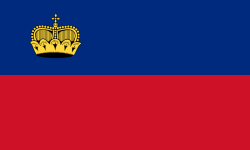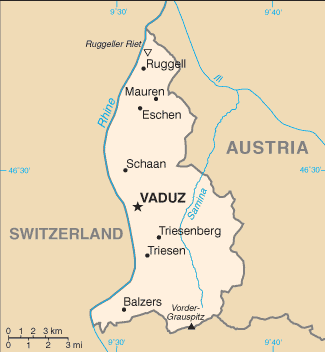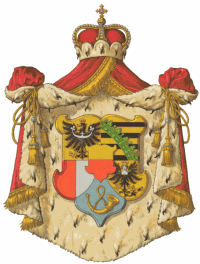Principality of Liechtenstein
Related Categories:
 Flag of the Principality of Liechtenstein
Flag of the Principality of LiechtensteinTwo equal horizontal bands of blue (top) and red with a gold crown on the hoist side of the blue band. |

 Liechtenstein Coat of Arms
Liechtenstein Coat of Arms |
In 1937, the head of government Joseph Hoop presented officially the new flag and gave a symbolic interpretation of its colours.
www.fotw.us/
At one time, the territory of Liechtenstein formed a part of the ancient Roman province of Raetia. For centuries this territory, geographically removed from European strategic interests, had little impact on the tide of European history.
en.wikipedia.org/
The Liechtenstein Family of Austria acquired the fiefs of Vaduz and Schellenberg in 1699 and 1713 respectively, and gained the status of an independent principality of the Holy Roman Empire in 1719 under the name Liechtenstein. The French, under Napoleon, occupied the country for a few years, but Liechtenstein regained its independence in 1815 within the new German Confederation. In 1868, after the Confederation dissolved, Liechtenstein disbanded its army of 80 men and declared its permanent neutrality, which was respected during both world wars.
In 1919, Liechtenstein entrusted its external relations to neutral Switzerland. After World War II, Liechtenstein became increasingly important as a financial center, and the country became more prosperous. In 1989, Prince Hans Adam II succeeded his father to the throne and in 1996 settled a long-running dispute with Russia over the Liechtenstein family's archives, which had been confiscated during the Soviet occupation of Vienna in 1945 and later moved to Moscow. In 1978, Liechtenstein became a member of the Council of Europe and then joined the UN in 1990, the European Free Trade Association (EFTA) in 1991, and both the European Economic Area (EEA) and World Trade Organization (WTO) in 1995.
www.state.gov/r/
Introduction
About
Contact
Symbols in The News
Interpret this Symbol
AAC
African
AI
Alchemy
Alphabets
Ancient
Animal Symbolism
Architecture
Art
Articles
Astrology
Baha'i
Blissymbolics
Blueprint Symbols
Buddhist
Celtic Symbols
Cemetery
Chinese Symbols
Christian
Circle
City
Codes
Color
Conlangs
Crop Circles
Danger
Da Vinci Code
Designing Logos
Dictionaries
Dreams
Education
Egyptian Symbols
Electrical
Emoticons
Find Images
Fonts
Food
Fraternity
Hamsa
Healing
Heraldry
Hermetic
Highway Signs
Hindu
History
Hobo
Holiday
Icons
iConji
Islamic
Jain Symbols
Japanese, Kanji
Jewish
Justice
Law
Literary Symbolism
Mandalas
Map
Masonic
Math, Number
Meaning of Names
Medical
Middle East
Military
Miscellaneous
Money
Music
Mythology
Native American
Playing Cards
Power
Psychology
QiQiiKhu
Reiki
Religious
Runes, Norse
Sacred Geometry
Scientific
Science Fiction
Sorority
Sports
Symbols in the News
Tattoos
ThirteenSymbols
Tree of Life
Ursprache
Videos
Visual Languages
Weather
Web Codes
Wicca
Words
Writing Systems
Braille
Coinherence
Coptic
Cuneiform
Easter Island
Etruscan
Happy Human
Hebrew
Kokopelli
Linear B
Lotus
Love Symbols
Mandorla
Moon Alphabet
Nine Pointed Star
Om
Oz
Phonetic
Scarab Beetle
Silent
Theosophy
Unifon
About
Contact
Symbols in The News
Interpret this Symbol
AAC
African
AI
Alchemy
Alphabets
Ancient
Animal Symbolism
Architecture
Art
Articles
Astrology
Baha'i
Blissymbolics
Blueprint Symbols
Buddhist
Celtic Symbols
Cemetery
Chinese Symbols
Christian
Circle
City
Codes
Color
Conlangs
Crop Circles
Danger
Da Vinci Code
Designing Logos
Dictionaries
Dreams
Education
Egyptian Symbols
Electrical
Emoticons
Find Images
Fonts
Food
Fraternity
Hamsa
Healing
Heraldry
Hermetic
Highway Signs
Hindu
History
Hobo
Holiday
Icons
iConji
Islamic
Jain Symbols
Japanese, Kanji
Jewish
Justice
Law
Literary Symbolism
Mandalas
Map
Masonic
Math, Number
Meaning of Names
Medical
Middle East
Military
Miscellaneous
Money
Music
Mythology
Native American
Playing Cards
Power
Psychology
QiQiiKhu
Reiki
Religious
Runes, Norse
Sacred Geometry
Scientific
Science Fiction
Sorority
Sports
Symbols in the News
Tattoos
ThirteenSymbols
Tree of Life
Ursprache
Videos
Visual Languages
Weather
Web Codes
Wicca
Words
Writing Systems
Braille
Coinherence
Coptic
Cuneiform
Easter Island
Etruscan
Happy Human
Hebrew
Kokopelli
Linear B
Lotus
Love Symbols
Mandorla
Moon Alphabet
Nine Pointed Star
Om
Oz
Phonetic
Scarab Beetle
Silent
Theosophy
Unifon
